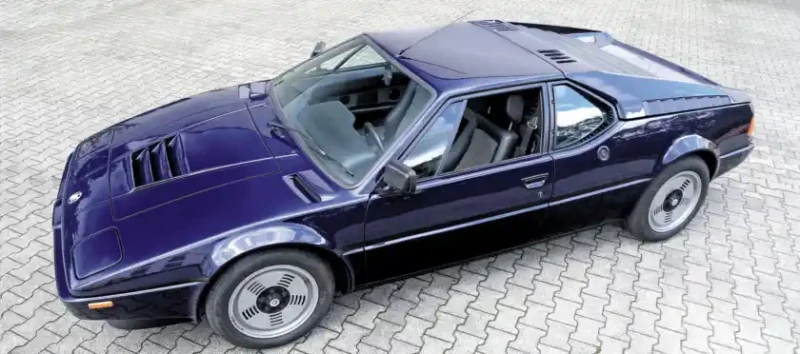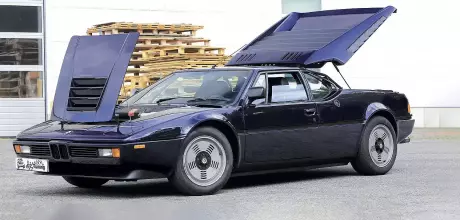1980 BMW M1 3.5 Coupe E26
The history of the BMW M1 is a tragic one. First, Lamborghini put the entire project in jeopardy, then the botched Group 4 homologation and the second oil crisis shocked everyone. But owning one of the only 453 mid-engine speedsters built as a result is all the more enjoyable, as Reiner Ahrend knows.
Italian as the M1 E26, no BMW could get
As a die-hard BMW enthusiast, he turned his hobby into a profession and has been taking care of the well-being of the sporty two-door models, especially the earlier 3 Series, since 1985 through his company, Ahrend 02 Tuning. But that's not all, as Reiner, an entrepreneur from Rösrath, explains: Around 2011, I met a collector whose fleet I have been looking after since. He fulfilled a long-cherished dream the previous year and bought a BMW M1. This rarity, acquired from another collector, was originally delivered to Switzerland. Its first registration in Germany didn't happen until 1983, so the car received its historic H-plate quite late. Until then, this mid-engine coupe with around 40,000 kilometers had been standing still for years, resulting in various issues like seized brakes, a leaking coolant pipe, and clogged nozzles on the Kugelfischer pump that I had to fix in 2012-2013.

When dealing with a used car, one might raise their eyebrows at these investments, but in the case of this not only rare but also highly regarded classic, these repairs were a mere trifle: «Unlike many of its 53 siblings from the Procar series, this M1 didn't suffer any bruises but remained completely accident-free. And it's still in its original paint! Only 59 cars left Italdesign in blue, where the GFK bodywork from T.I.R. in Modena was combined with the frames manufactured by Marchesi from the same town, following Lamborghini's specifications, then glassed, equipped with electrics, and finally painted. Only eight silver, black, and gray M1s are rarer. The fabric-leather interior also looks brand new, but it has been in the same place as the sky for years, contributing significantly to its dreamlike collector's condition,» Reiner explains.
«From the very first meter, you can tell that the M1 was derived from the racing version, not the other way around,» the expert continues. «This applies not only to the body but also to the chassis. The layout can handle power up to nearly 1000 horsepower of the turbo racing version without major modifications. Originally, V8 and V12 engines were considered, but for cost reasons, BMW stuck to its guns and created the legendary M88 engine based on the existing M90 inline-six, with a newly developed four-valve head and dry-sump lubrication. With its mechanical fuel injection and six individual throttle bodies, it roars like a lion and packs plenty of power,» the entrepreneur grins.
The 277 horsepower allowed for 5.6-second sprints from 0-62mph (0 to 100kmh) and a brisk 262 km/h top speed – making the M1 the fastest German sports car until Porsche increased the 911 Turbo 930 to 330 horsepower at the end of 1983. By that time, the M1 was already available as a used car. The 453rd and final BMW M1 E26 had left Baur's assembly hall in Stuttgart at the beginning of February 1981, with deliveries starting in February 1979. Unfortunately, the late start of production meant that the M1 arrived too late for the timely homologation for Group 4 and Group 5 races in 1979. The delay was attributed to engine-related issues and the bankruptcy of development partner Lamborghini. Initially, many potential buyers were excited, but they were disappointed by the M1's modest performance compared to its Italian competitors, causing it to fall far short of the predicted sales target of 800 units.
However, no one blames the Flachmann that emerged from the 1972 Turbo E25 study for this failure these days, as Reiner knows: «As part of my collection management, I occasionally showcase the blue wonder at events. When I visited the Edelweiß-Bergpreis Rossfeld Berchtesgaden, I once again realized that not only clothes but also cars make the people. So, I didn't have to park outside but was easily invited onto the premises and allowed to showcase the M1 in the middle of the pit lane among all the registered race cars. Only a victory would have pleased the creators even more!»
Verdict:
The BMW M1, a true legend in the world of sports cars, has a history filled with both triumph and adversity. From its Italian design influence to its racing roots, the M1 is a remarkable piece of automotive history. In this article, we'll explore the story of the BMW M1 and its enduring legacy.
Italian Influence on the BMW M1:
The BMW M1's design, with its unmistakable Italian flair, was a result of the collaboration between BMW and the renowned Italdesign. Giorgetto Giugiaro, the mastermind behind the car's striking exterior, drew inspiration from Ghia's DeTomaso Pantera. The result was a visually captivating mid-engine sports car that stood out in the crowd.
Racing Roots and Mechanical Brilliance:
The BMW M1 E26 was not just a beautiful car; it was also built for racing. Its chassis and layout could accommodate significant power upgrades, making it a force to be reckoned with on the track. Under the hood, the M1 featured the groundbreaking M88 engine, known for its mechanical fuel injection and six individual throttle bodies. This powerplant produced a thrilling roar and delivered 277 horsepower, allowing the M1 to sprint from 0 to 100 km/h in just 5.6 seconds and reach a top speed of 262 km/h.
Challenges and Collectible Rarity:
Despite its racing pedigree, the BMW M1 faced challenges, including delays in production and difficulties in meeting racing homologation requirements. The M1 arrived too late to compete in Group 4 and Group 5 races in 1979. As a result, it fell short of the initial sales target. Today, however, the M1 is highly regarded as a collectible classic, with only 453 units ever produced.
Conclusion:
The BMW M1 remains a symbol of Italian design and German engineering, blending aesthetics and performance in a unique package. With its racing heritage and timeless appeal, the M1 is a cherished gem in the world of sports cars.
TECHNICAL DATA1980 BMW M1 3.5 Coupe E26
- General: The road version of the BMW M1 accelerates from 0 to 100 km/h in just 5.6 seconds and reaches a top speed of 262 km/h. The BMW M1 was produced between 1978 and 1981. Its current estimated value starts at €500,000 and can increase based on its condition. It's worth noting that in 1978, the M1 was available as a new car for «only» €100,000.
- Engine: The BMW M1 is powered by the M88 DOHC inline-six engine, mounted longitudinally in the middle of the car. It boasts a displacement of 3453 cc with a compression ratio of 9.0:1. The engine features a mechanical Kugelfischer fuel injection system with individual throttle bodies, dry-sump lubrication. The car's exhaust system includes a dual-pipe setup.
- Max Power: 277bhp at 6500 rpm
- Max Torque: 330Nm at 5000 rpm
- Transmission: Power is delivered to the rear wheels through a five-speed manual transmission, ensuring a truly engaging driving experience.
- Chassis: The M1 features a double-wishbone suspension system with coil springs and Bilstein gas-pressure shock absorbers at the front and rear, ensuring superb handling and ride comfort.
- Wheels and Tires: The M1 boasts individual wheel suspension with Campagnolo-M1 alloy wheels, measuring 7x16 inches at the front and 8x16 inches at the rear. The tires are Pirelli «Cintauro» with sizes of 205/55 R16 at the front and 225/50 R16 at the rear.
- Body: The car's body is painted in blue and constructed from lightweight GFK (glass-fiber-reinforced plastic). It features a tubular steel frame, contributing to a curb weight of 1300 kg.
- Interior: Inside the M1, you'll find a combination of fabric and leather upholstery. The steering wheel and gear shifter are wrapped in leather for a premium feel. The car is equipped with a Becker «Mexiko» cassette radio for entertainment.
- Fuel: The M1 requires Super Plus fuel to power its high-performance engine.


